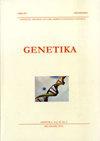面包小麦重组自交系产量的AMMI分析
4区 农林科学
Q3 Agricultural and Biological Sciences
引用次数: 0
摘要
鉴定高产相对稳定的基因型是植物育种计划的一个整体目标。为了确定基因型的产量稳定性,需要对不同环境下的基因型进行测试。采用加性主效应和乘法互作(AMMI)模型,对44个面包小麦重组自交系(RILs)和6个对照品种的籽粒产量进行了环境互作(GEI)基因型分析。试验采用α格子设计,在巴基斯坦开伯尔-普赫图赫瓦省白沙瓦(E-1和E-3)、汉古(E-2和E-4)和科哈特(E-5)进行2个重复种植。方差分析表明,各性状间的遗传风险系数均存在显著差异,除出苗期和千粒重外,其他性状间基因型与环境的相互作用均显著。重要的GEI证明了环境特异性和AMMI分析的合理性,以确定具有特定和更广泛适应性的ril。AMMI分析表明,第一次互作主成分分析(IPCA 1)占GEI平方和的64%,第二次互作主成分分析(IPCA 2)占互作平方和的25.8%。AMMI双图显示G30为高产基因型,G19和G49次之,而G13、G8和G7为低产基因型。同样,G30是最稳定的RIL,靠近IPCA1轴,适应性更广,其次是G31和G25。根据AMMI稳定性值(ASV),按相对稳定性的顺序识别出G18(2.15)、G5(2.78)、G27(3.72)、G44(4.31)、G25(4.43)、G42(4.57)、G43(5.78)、G11(5.82)、G1(7.66)和G29(7.81)。稳定性分析鉴定G49 (Wafaq ?Ghaznavi-98-3)为高产稳定基因型,满足程序要求后可实现商业化。本文章由计算机程序翻译,如有差异,请以英文原文为准。
AMMI analysis for grain yield in bread wheat recombinant inbred lines
Identification of high yielding relatively stable genotypes is an integral objective of plant breeding programs. Testing of genotypes across environments is required to determine yield stability of genotypes. The specific objective of the current study was to analyze genotype by environment interaction (GEI) for grain yield of 44 bread wheat recombinant inbred lines (RILs) and six check cultivars using additive main effect and multiplicative interaction (AMMI) model. Experiments were planted using alpha lattice design with two replicates in Peshawar (E-1 and E-3), Hangu (E-2 and E-4) and Kohat (E-5) Khyber Pakhtunkhwa province, Pakistan. Analysis of variance revealed significant differences among RILs for all traits while interactions due to genotype by environment were significant for all traits except days to emergence and 1000-grain weight. Significant GEI justified environment-specific as well as AMMI analysis to identify RILs with specific and wider adaptation. The AMMI analysis revealed that the first interaction principal component analysis (IPCA 1) captured 64% of GEI sum of squares while the second interaction principal component analysis (IPCA 2) explained 25.8% of the interaction sum of square. The AMMI biplot identified G30 as high yielding genotype followed by G19 and G49, whereas low yielding RILs were G13, G8 and G7. Similarly G30, being close to IPCA1 axis, was the most stable RIL with wider adaptability followed by G31 and G25. Based on AMMI stability value (ASV), RILs G18 (2.15), G5 (2.78), G27 (3.72), G44 (4.31), G25 (4.43), G42 (4.57), G43 (5.78), G11 (5.82), G1 (7.66) and G29 (7.81) were recognized in the given order of relative stability. Stability analysis identified G49 (Wafaq ? Ghaznavi-98-3) as high yielding stable genotype among RILs which can be commercialized after fulfilling procedural requirements.
求助全文
通过发布文献求助,成功后即可免费获取论文全文。
去求助
来源期刊

Genetika-Belgrade
AGRONOMY-GENETICS & HEREDITY
CiteScore
1.80
自引率
0.00%
发文量
1
审稿时长
6-12 weeks
期刊介绍:
The GENETIKA is dedicated to genetic studies of all organisms including genetics of microorganisms, plant genetics, animal genetics, human genetics, molecular genetics, genomics, functional genomics, plant and animal breeding, population and evolutionary genetics, mutagenesis and genotoxicology and biotechnology.
 求助内容:
求助内容: 应助结果提醒方式:
应助结果提醒方式:


